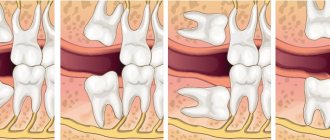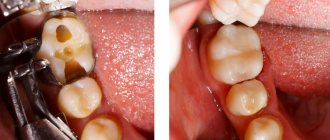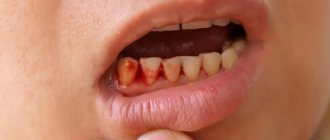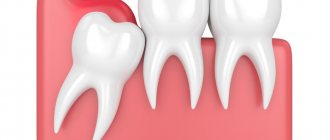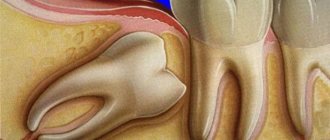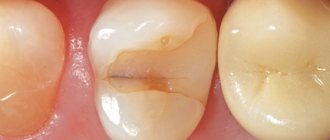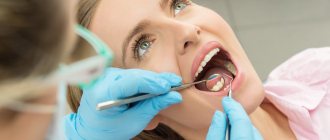A wisdom tooth is the 8th tooth in a row (figure eight) or 3rd molar, its eruption period is 17-25 years. This is a large molar, often with a complex root system. The peculiarities of its development and growth in most cases become the cause of various dental problems. Although the structure of the figure eight is characterized as an ordinary molar, its chewing function is practically absent. If a wisdom tooth hurts, it is rarely preserved. The figure eight is destroyed early, often erupts with a carious lesion, grows at an angle or in a horizontal position.
How can you tell if your wisdom tooth hurts?
Eights erupt much later than all the other teeth in the row, when the dentofacial apparatus is fully formed, and there is simply not enough space for a beginner. Due to the density of the gums and bone tissue, eruption is quite painful, accompanied by inflammation of the gums and damage to neighboring units. Pain during wisdom tooth growth is quite specific:
- Spreads along the jaw, extends to the temple, neck, head, ear, throat;
- around the figure eight there is swelling and redness of the gum tissue;
- due to pain and sore throat, swallowing is difficult;
- numbness of the jaw and severe pain indicate that the 3rd molar is growing crookedly, injuring the jaw nerve;
- it is difficult to open your mouth, especially if the wisdom tooth grows in the opposite direction from the jaw.
Each similar symptom indicates the presence of problems with the 3rd molar. You can temporarily relieve pain when wisdom teeth erupt with an analgesic. If the figure eights grow crookedly, the bite is disturbed, the cheek or gums are injured, they form in the bone tissue without erupting to the surface or appear only partially - they must be removed.
Features of the structure and eruption of wisdom teeth
Unlike other teeth, the rudiments of “eights” are formed not during intrauterine development, but at 3–5 years, when the child’s body is preparing to change the primary dentition to a permanent one. At this age, you can determine the number of future eights (from one to four). However, it is impossible to detect possible developmental pathologies at this stage.
The crown part of third molars is formed at approximately 12 years of age, but the development of the root part takes several more years and can continue even after tooth eruption. Considering that the most common age for the appearance of third molars is 18–25 years, the eruption of wisdom teeth occurs already in adults. However, approximately 10 - 15% have no eights at all, which is why it is considered normal for an adult to have from 28 to 32 teeth.
Why can a wisdom tooth hurt?
- Non-standard eruption
- impacted teeth formed in the jawbone, not erupted completely or partially, can be positioned horizontally or vertically. When the figure eight is placed on the side, it puts strong pressure on neighboring units, causing acute pain. - Gum hood
– dense gums can prevent teething; a “hood” of mucous tissue forms over the wisdom tooth. Bacteria and food particles begin to accumulate under it, which cannot be removed when brushing your teeth. This area is constantly injured, inflamed, and painful. An acute inflammatory process often develops into a purulent one. - The molar is rotated
around its axis - the more pronounced the rotation, the stronger the impact on the dental nerve, which causes pain in the molar itself, the adjacent unit or the entire jaw. - The cheek hurts
due to a wisdom tooth if it grows in its direction. The pain intensifies when chewing, the mucous membrane of the cheek is constantly injured and inflamed. - Caries
- the localization of the 3rd molar makes it difficult to care for it; often it is cut already with carious lesions of hard tissues, which causes pain. The sensitivity of the tooth increases, it reacts painfully to temperature and chemical stimuli. - Cyst
- due to systematic injury to the gum tissue, the molar itself, a cystic formation may form at the neck. A wisdom tooth cyst is often accompanied by serious complications - inflammation of the periodontal tissues, pericoronitis, abscess, and destruction of bone tissue.
Also, the reason that the wisdom tooth began to hurt are various dental pathologies - pulpitis, periodontitis (acute, chronic), periodontal disease. Removing the figure eight is not always justified; the doctor decides this issue individually, depending on the clinical picture. First, a comprehensive diagnosis is carried out, the doctor determines the location of the roots, assesses the condition of the jaw bone, gums around the figure eight, and the entire dentofacial apparatus.
Why does a wisdom tooth hurt as it grows?
There are only 5 causes of such pathological, often unbearable, pain.
- Not enough space in the dentition .
Wisdom teeth are rudiments; we inherited them from our ancestors, whose jaw was 10-12 centimeters wider. Now, many people simply do not have room in their teeth to fit another tooth. But the “extra” molar is growing. And even if the direction of growth is correct, the impostor puts pressure on the teeth in front, moves them to the center and, in the end, wins back its place. This process, which occurs in the thickness of the bone, is very unpleasant and painful. And it ends with unaesthetic crowding of teeth. - Wrong direction of growth .
It is impossible to predict how a wisdom tooth will grow. If you're lucky, it will become clearly vertical. But very often its axis is deviated to the side. And then, at best, the tooth will scratch the gums, tongue or palate. At worst, it will begin to push the roots of the “seven”, inevitably destroying it. Pain due to dystopia, which is what dentists call the pathological direction of growth of the “eight”, is impossible to withstand without strong painkillers. It shoots and crushes, cuts and stabs, hits the ear and temple, not allowing you to forget for a second about the culprit of the torment. - Development of bacterial infection .
When the teething process drags on for months, or even years, a so-called “hood” forms over the wisdom tooth. It is formed by the gum covering the molar. Food debris inevitably gets into this fold, and the inability to maintain proper care leads to inflammation - pericoronitis. Its main symptom is an increase in body temperature, which can reach 400 C. In this case, the patient complains of constant aching pain, the inability to talk, eat, and sometimes even open his mouth. Upon examination, swelling and redness of the gums are clearly visible. - Trigeminal neuralgia .
Perhaps the most vivid sensations of pain were experienced by those people whose wisdom tooth once touched one of the branches of the trigeminal nerve. They provide sensitivity to facial tissues, soft tissues of the mouth and teeth. And if a wisdom tooth presses on a nerve, unbearable pain begins, affecting not only the jaw, but also the throat, ear, and head. The patient cannot even understand what hurts more. - Caries, pulpitis, periodontitis .
Just like other teeth, the third molar can become diseased. More often this happens with an already erupted tooth. But sometimes an infection that gets under the hood affects not only the soft tissues, but also the wisdom tooth itself. And then the dentist will have to decide whether it is worth treating the disease, or whether it is easier to immediately remove the third molar.
Wisdom teeth removal with 20% discount
Moscow
Indications for removal
- Pathological eruption of the figure eight (partial or complete retention, dystopia), accompanied by pain, chronic inflammation of the gums, destruction of adjacent molars, malocclusion, damage to the jaw joint and other problems;
- 3 molar has erupted outside the dentition, leading to crowding;
- inability to carry out treatment or prosthetics due to limited access to the dental unit;
- the presence of complications - cysts, granulomas, periostitis, periodontitis;
- orthodontic treatment - figure eights must be removed if they interfere with the installation of a corrective apparatus or prevent the teeth from taking the correct position when correcting the bite.
When do you need a doctor's help?
If the figure eight hurts, you should immediately consult a dentist. Consultation with a specialist is also necessary for pain of unknown etiology - squeezing, spreading over the entire jaw, occurring when chewing or opening the mouth. After examination and diagnosis, the doctor will decide what to do next with the molar. If the growth of a wisdom tooth is accompanied by swelling, redness of the gums, and acute pain, the doctor will prescribe anti-inflammatory therapy.
If eruption is difficult due to the gingival hood, an operation will be performed to excise it and drug therapy will be prescribed.
Types of toothache that go to your head
Dental problems can have different manifestations. One of them is acute pain that radiates to the jaw, temporomandibular joint, temples, and can also cover the entire surface of the head. Diseases can occur due to inflammation of tissues, injuries and abnormalities in the structure of bones and joints, and damage to teeth. A common feature for them is a tendency to constant progression, so the diseases require timely treatment.
Caries
Caries is a disease with a slow but progressive course. It begins with damage to the enamel and continues with the destruction of the internal structures of the tooth. In the future, the disease can be complicated by inflammation of the pulp, as well as periodontitis. Doctors identify a number of reasons that can lead to the development of caries:
- the presence of hard plaque and stones on tooth enamel;
- insufficient oral hygiene, as a result of which microorganisms have a detrimental effect on the enamel;
- anatomical features, the presence of gaps and spaces between teeth;
- the concentration of fluoride in the enamel - the lack of this element increases the sensitivity of the teeth.
Tooth decay can damage the deep structures of the tooth, leading to nerve inflammation. This process is accompanied by acute, throbbing pain that can spread to the entire jaw and radiate to the head. Treatment consists of removing damaged tooth structures and installing a filling; if necessary, complete tooth extraction is performed. According to the decision of the doctor and the patient, implants are installed.
Cyst
A cyst is a pathological cavity surrounded by a capsule. It appears near the root of the tooth as a result of caries, as well as when an infection occurs during dental prosthetics or installation of crowns. Pathogenic microorganisms cause inflammation, which is controlled by the immune system. However, the tissues are destroyed, and a dense protective capsule is formed around them. The process can progress, which is dangerous due to the destruction of the jaw bones, rupture of the cyst and the entry of decay products into the bloodstream. It is important that the cyst may not show any symptoms in the early stages, but requires urgent removal immediately after its discovery.
Displacement of the jaw head
One of the reasons why dental problems are accompanied by headaches is dysfunction of the temporomandibular joint. It is paired and normally symmetrical, provides mobility to the lower jaw and connects it to the bones of the skull. He is constantly in motion and takes part in many processes: chewing, swallowing, speaking, yawning and others. The joint is formed by the fossa of the temporal bone and the head located on the lower jaw. Incorrect position of this particular element leads to dysfunction of the joint.
There are a number of reasons that can cause temporomandibular joint dysfunction:
- malocclusion;
- removal or loss of teeth;
- quick erasing of chewing surfaces;
- injuries, jaw fractures, pathologies during rehabilitation;
- high speech load.
Temporomandibular joint dysfunction can be diagnosed by characteristic signs: a clicking sound when opening the mouth, pain in the temples, difficulty moving the lower jaw. However, these diseases can also present with atypical symptoms, including headache, hearing and vision impairment, snoring and sleep apnea.
Other reasons
Headaches can be a manifestation of acute and chronic dental diseases. A more detailed examination reveals various abnormalities, including:
- inflammatory diseases of the teeth and oral cavity;
- incorrect installation of implants, errors in prosthetics;
- inflammation or mechanical compression of the dental nerve;
- malocclusion is often a congenital pathology that can be corrected in childhood;
- arthrosis, arthritis of the temporomandibular joint caused by various factors.
It is impossible to make an accurate diagnosis at home, so it is important to consult a specialist in time for examination. It is important to remember that some diseases are asymptomatic in the initial stages, and their manifestations may be atypical. Thus, toothache must be distinguished from migraines and other types of headaches.
Wisdom teeth removal methods
The intervention tactics depend on the location of the 3rd molar, the degree of exposure to the gum surface, the number of roots, their confusion, and the position of adjacent teeth. Removing figure eights on the upper jaw is easier than on the lower jaw. This is due to the structure of the jaw tissue - the maxillary bone is looser, more airy, the mandibular bone is more massive and dense. Additionally, mandibular eights tend to have more tangled and developed roots.
According to the clinical picture, removal can be simple or complex. A simple extraction is performed like any other extraction - the molar is rocked with forceps and removed from the socket. Complex technology includes:
- gum incision;
- drilling a molar or sawing it into fragments;
- removing each fragment one by one;
- suturing the wound.
Stitches are removed on days 5-7
after the intervention (self-absorbable suture material can be used). The operation is performed under local anesthesia; removal under sedation (during medicinal sleep) is possible.
Treatment of wisdom teeth during pregnancy has its own nuances. Usually, the doctor limits himself to conservative therapy aimed at eliminating pain and inflammation. If possible, removal is performed after childbirth. The operation is carried out according to strict indications, if the inflammation has become purulent and threatens the health of the mother and child. For anesthesia, special drugs are used that are safe for the fetus.
At the RUTT clinic, the removal of a wisdom tooth with a complex root system and location is performed by experienced maxillofacial surgeons. This eliminates surgical complications - extensive trauma to the bone structures of the jaw, perforations, wandering root remains, postoperative fistulas, osteomyelitis, etc. Only maxillofacial surgeons have enough skills and experience to perform such interventions without complications.
Is it painful to have a wisdom tooth removed?
Is wisdom tooth extraction accompanied by pain? This is one of the most common questions.
The fact is that very rarely “eights” grow healthy; usually their eruption causes pathological processes that are dangerous to the patient’s health, so their removal is required. Surgical removal of the “eight” is always accompanied by pain, the process is especially difficult due to curvature and other disorders of the third molar. The procedure must be carried out with the use of painkillers. Most often, dentists use drugs based on articaine - “Ultracaine”, “Ubistezin”. The use of local anesthetics allows you to completely eliminate pain during surgery. However, the process of administering the drug itself may be accompanied by pain. In addition, when the anesthesia wears off (after about 6 hours), intense pain occurs.
Severe pain during the removal of the third molar is inevitable in cases where the patient has not consulted a specialist for a long time, the inflammatory process has started, resulting in purulent formations. Sometimes tooth extraction is performed under general anesthesia. In other situations, surgery is painless.
The upper “eights” are much easier to remove than the lower ones. This feature is due to the fact that wisdom teeth in the lower dentition have more powerful and sinuous roots. To properly carry out the procedure for removing the third molar, the dentist sends the patient for an x-ray before the operation.
Recovery after surgery
The removal of the figure eight itself is painless, since it is performed under anesthesia. But due to injury to the gums and bone socket, after the anesthetic wears off, the figure eight, or rather the periodontal tissues, hurt for several days. Painful sensations after a simple removal usually go away within 2-3 days, after a complex one they can persist for about a week. On days 2-3, swelling increases, which subsides after 2 days and the pain subsides. After the intervention, the doctor gives recommendations regarding care, nutrition, lifestyle, and prescribes drug therapy - antibiotics, painkillers, anti-inflammatory drugs, antihistamines.

